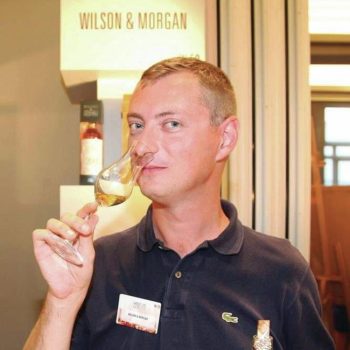SB meets… Luca Chichizola, Wilson & Morgan
By SB Staff WriterThe brand ambassador tells us how independent bottling has changed, and what Wilson & Morgan does to impart personality and perspective on the whiskies it selects.

What qualities make a single malt whisky right for Wilson & Morgan?
Founder Fabio Rossi has long believed that an independent bottler must do something different to have a recognised place among connoisseurs, that it must have personality above everything else. Sometimes a batch of casks has one or two that stand out as especially different. They are not the standard distillery profile a blender would choose, but that’s exactly why we like them. What drives our longtime fans to choose our bottlings is they know that it will be a whisky that tastes different; bottled at 46% and 48% ABV, sometimes cask strength, not chill‐filtered, not coloured, often as single cask.
How does Wilson & Morgan impart perspective on the barrels it selects?
In more than 30 years of activity we have built a large stock of casks from many distilleries up to 35 years of age, single malts and a few grains. We take particular care on the wood we select to re‐rack the whisky at a young age. We have experimented with some of the best bodegas in Jerez for the supply of oloroso and Pedro Ximénez Sherry casks, hogsheads and butts, or American and European wood, but also with virgin European oak, rejuvenated wood, Hungarian Tokaji, so we can shape them to the style we like. We were the first to introduce Sicilian Marsala finish in 2000! We like to experiment both with first‐fill casks, and second‐fill for longer and subtler maturation periods.
How has independent bottling changed in recent years?
When Wilson & Morgan started in 1992, there were few independent bottlers. There was plentiful stock of quality whisky in the Scottish warehouses. In the last 10 years independent bottlers multiplied, worldwide demand has risen, and prices have rocketed. Whisky production has become more standardised, which is good for consistency but not as good for finding standout casks. An independent bottler must rely on his stock of casks, let them mature in the years, not try to bottle and monetise quickly. We taste over 200 samples per year, which is 15% of the casks we own. We make notes of each cask, and we re‐sample after two or more years to check how they are developing. Once our tasting panel gives the green light, we bottle it.
Are there any specific bottlings that are especially memorable?
A real stunner was the Dailuaine 40‐year-old, distilled in 1983 and bottled in 2023. We released it in a special cut‐glass decanter. It’s our most expensive bottling ever, but it’s a real beauty, with 40 years of maturation in oloroso Sherry. Among new bottlings to come, there will be 30‐year-olds from Old Rhosdhu, Cameronbridge, Tobermory, and Glen Keith that will show elegance and complexity. But just have a look on Whiskybase, where we have some legendary bottlings with the highest ratings in past years: Ardbeg 1974, Springbank 1969, Laphroaig 1998, Port Ellen 1979…
Which markets and demographics do you most resonate in?
Italy has a long and faithful following, but we are also doing well in Germany, Austria, the Netherlands, and Denmark. Hungary has seen a huge increase in the past few years. Taiwan, China, and Japan have a loyal following, especially for the older and more luxury bottlings. And recently, we entered the Dubai market, with some of our most prestigious releases offered in the duty free shops.
What contributes to Wilson & Morgan’s longevity?
The passion we have in tasting so many casks every year. Long traditions and our boutique approach. Our followers recognise our brand style, approach to quality, and established loyalty to the customer. While we keep growing and making Wilson & Morgan known to new whisky drinkers, most of our customers are returning.
Related news
Rod Stewart’s whisky brand booms in Germany
